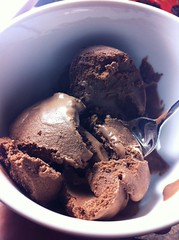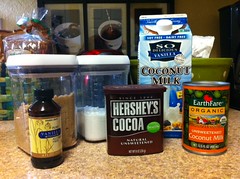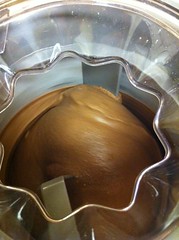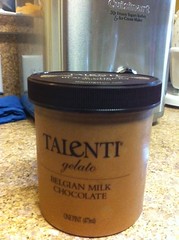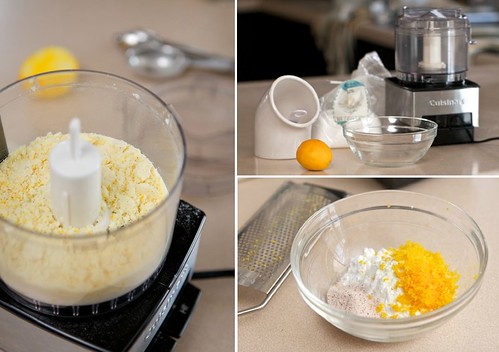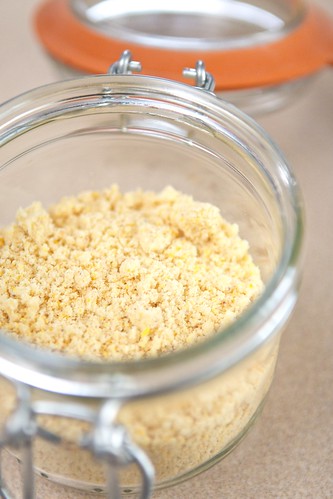Here is a picture of some bread I attempted to make last year:
So sad, it didn't rise. I have bread problems. This is another thing I'd love to start making in our house instead of buying. The nice whole-wheat-big-slice-sandwich-bread we like is pricey! Yet, the few times I've tried to make nice bread it hasn't worked. I can do quick breads and rolls but that's about it. Emma from City Roots, County Life seems to have the whole bread making thing down. It's hopeful to see other people try and succeed in bread making, perhaps I should try it again? She's joining the Make It Yourself month with the last post in the series all about bread. I love what their blog is all about: "First, it is the story of our transformation from a suburban family to a country family. But more importantly, we want this site to be both a resource and an inspiration to others who are thinking about making the move out to the country. We truly believe that living in the country is what we’re being called to do, but that doesn’t make it any less scary. If you’re a family considering making the shift to a more rural, simplified, and self-sustaining life, we hope that our tales here will give you hope that if two city slickers like us can make it work, surely most anyone can." Check it out and in the meantime here is Emma:
When Danielle asked me to guest post for her series on Make It Yourself, I was completely flattered. I am anything but an expert about making bread from scratch and I've certainly had a handful of failures. However, I've definitely learned that you can't expect to be perfect at something the first (few many) times around and often it's the journey that teaches you more than a recipe in a book will.
That being said, I highly encourage everyone to try making bread, from scratch, at home. I am not really known for being much of a baker, I'm more of a "cooker" as I have a distinct proclivity to change recipes as I go. Baking, however, doesn't really work like that, so I've had to be pretty disciplined about following the recipe. If you do follow the directions, you'll have a blast!
The internet is a wonderful resource if you're looking to dive into bread making. There are hundreds and hundreds of recipes out there and as many blogs dedicated to explaining how and why baking works the way it does. So far I've stuck to recipes that were specifically recommended to me or found poking around online. A couple you might try are listed below and contain links to my specific posts with photos, notes, and the original recipe:
Crusty White or Wheat Bread
Artisan Bread in 5 Minutes a Day
Amish White Bread
Here are a couple of tips that I have picked up so far:
- Read the directions. The entire thing. Start to finish, so you know what to expect. I always neglect to realize how long it takes when you include mixing, rising, punching, forming, and rising again. Look at your schedule and plan it out. If you want fresh bread with dinner at 6pm, you probably need to start before 3pm unless you've got the Artisan dough in the fridge. Plan ahead and make sure you have your ingredients together.
- If you live in a cool climate (or it's winter), have a warm place you can let your dough rise. Our thermostat is usually set about 72* so that's plenty warm for my bread to rise nice and high. If you leave your inside temperature around 50* though, you'll need to plan ahead! I've read of people turning the oven on "warm" and letting it preheat a few minutes, then prop the door open and let your bread rise in there.
- Preheat the oven. Give your oven a solid 20 minutes to preheat so the temperature is even and prepared for your loaves. It makes a big difference.
- If you want a crunchy crust, take a small pan (I use an 8x8" brownie pan) and put it in the oven on the lower rack while preheating. When you put the loaves in the oven, pour a cup of hot water into the brownie pan. It'll bubble and steam and help create a crispy crust on your bread.
- Give your bread at least a little time to cool. We have a tendency to want to break into the loaves as soon as they're out of the oven. While nothing beats bread still hot from the oven, the loaves will hold together better and slice easier if you let it cool a bit.
- The next time you buy bread from the store (I still do it, I haven't replaced all our bread-eating yet), save the large plastic bags and twist ties that they come in. My loaves tend to be too large to fit in a ziploc bag neatly and it's handy to have bread-sized bags stashed in the pantry for use. Just dump out the crumbs and you can reuse them over and over again. Homemade bread doesn't have the preservatives in it to keep it moist, so if you're storing any over night (and especially if you live in a drier climate, keep the bread in a bag until use. You will lose some of the crispy crust, but I'd rather have moist bread than crunch.
- And lastly, keep trying! Everyone has their own preferences on how they like their bread -- light and fluffy, dense and dark. Sourdough. Buttermilk. Herbs. White or wheat. I try to make a recipe three times before putting it on the shelf. This way I can (hopefully) isolate a mistake on my side and know if I really care for the recipe or not. I haven't found my all-time-favorite yet, but I am a fan of the artisan bread and have a batch in the fridge as we speak.
If you're looking to save money, making your own bread at home is a great way to do that! There are 4 basic ingredients in bread recipes, plus an extra here or there depending on the variety (ie - often sugar or honey). Here's the basic cost break down:
- Most recipes call for between 5 and 6 cups of flour. If you're just using standard, generic, all purpose flour this comes out to about 2 pounds. Add in some spillage, flour to dust your counter tops and rolling pin, and you can easily get 2 batches out of a 5 pound bag of flour. At about $2.50 per bag, that's about $1.25 in flour per recipe (often for 2 loaves). If you go through a lot of flour, you can get a 50 pound bag from a bulk warehouse store for about $11.50. That drops your per-loaf flour cost to $0.60.
- Yeast in individual packets are running $1.45 per pack of 3 here, so adjust for one or two packets per recipe depending on how much yeast is called for. Again, bulk is your friend and two pounds of yeast will run you $3.99 and make umpteen (likely hundreds of) loaves of bread and save you big time on your yeast expense.
- Water -- basically free from the tap. I'm not even sure how to calculate the cost for 3 cups of water. =P
- Salt -- A standard sized (26 ounce) canister of salt from the grocery store runs right at $1.00. You can get bulk non-iodized salt for $3.45 for 25 pounds, so your 1 -2 Tablespoons of salt will cost you pennies ... maybe.
When it's all said and done, you'll probably spend about $2.00 for 2 loaves of bread if you're buying standard items from the grocery store -- closer to $0.80 or $1.00. Comparing that to $3.29 for a standard, boring, store-bought loaf of bread and you'll save money nearly every time. And make your house smell wonderful in the process!
I hope this has encouraged you to hit up your pantry and make some bread! Remember, it doesn't have to look perfect to be delicious, to make your house smell divine, and to make a killer french toast for breakfast. =) I've love to get some feedback from you if you take the plunge!






